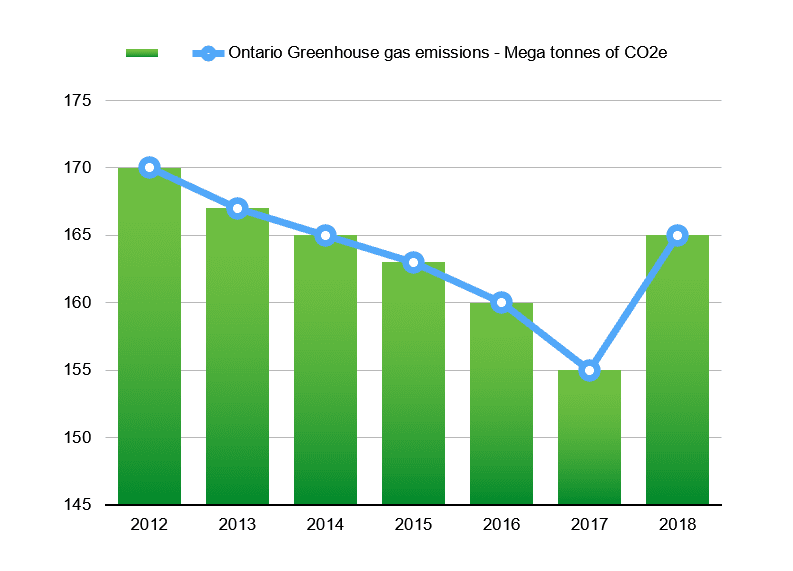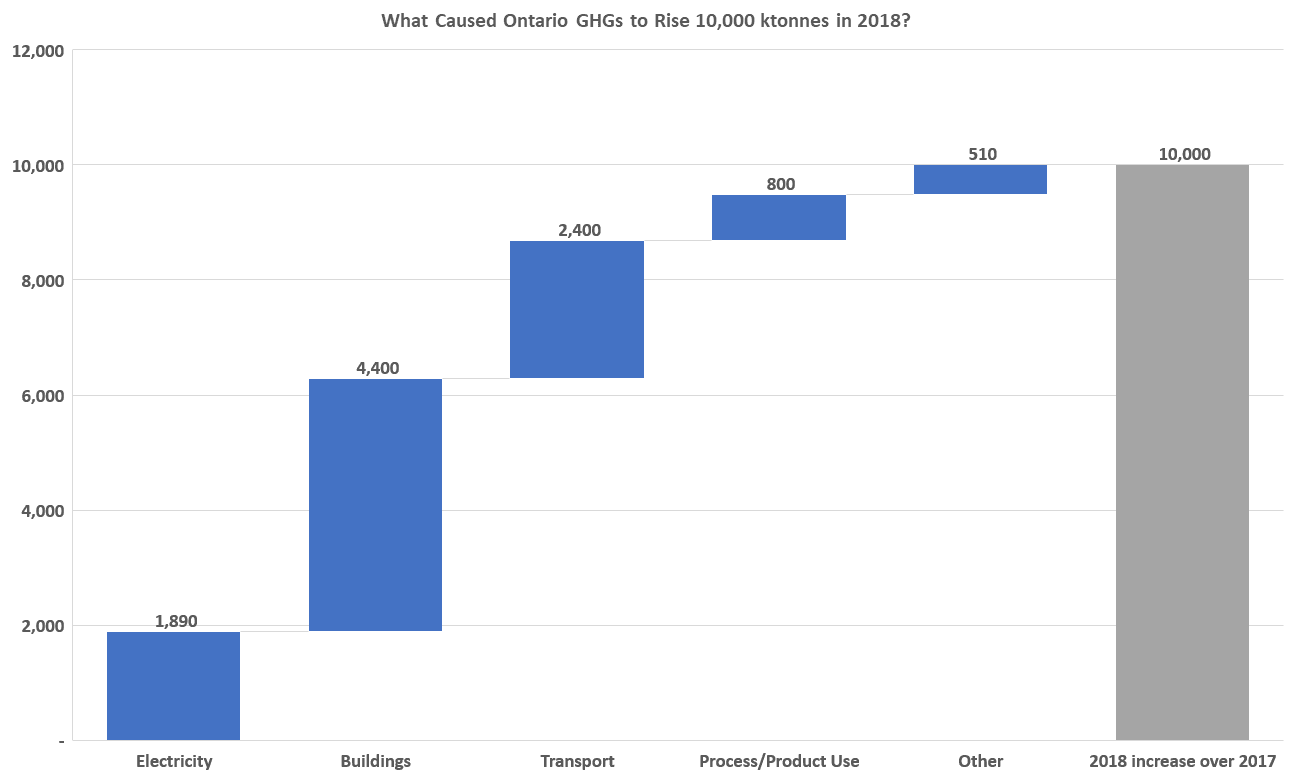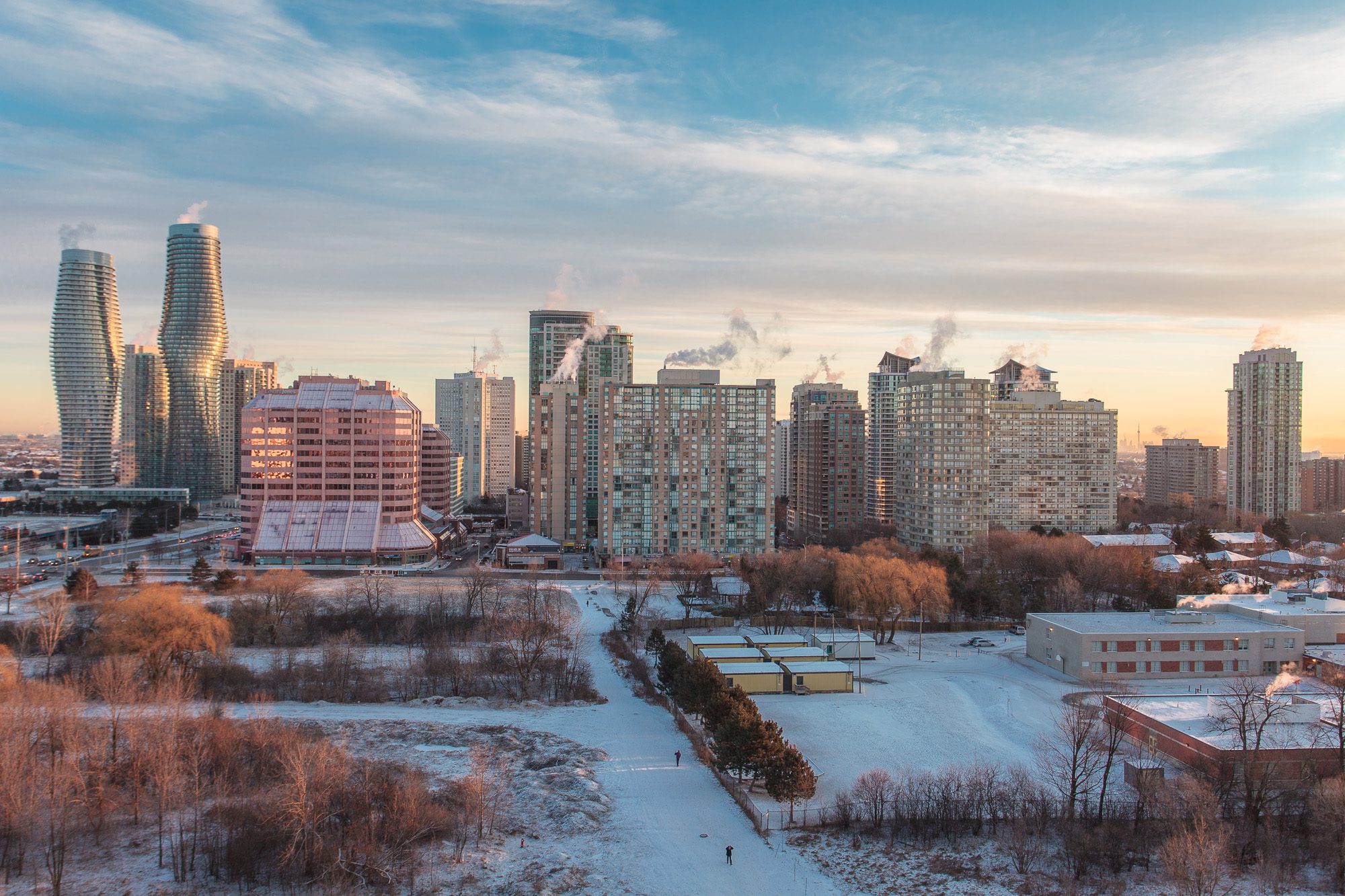We know that in order to fight climate change, Canada, and the world, needs to reduce greenhouse gas (GHG) emissions. Every spring, the federal government releases the most recent data they have on GHG emissions across Canada to see how well we are doing – nor not doing – to reduce these emissions. The data also gives us a glimpse into where emissions are coming from, which is critical to reducing them.
 This year’s release showed that GHG emissions from Ontario spiked in 2018 after declining for many years before this.
This year’s release showed that GHG emissions from Ontario spiked in 2018 after declining for many years before this.
The jump of 10 megatonnes – from 155 to 165 – is significant, and makes up two thirds of Canada’s total emissions increase that year of 15 Mts. But Ontario is only about 40 per cent of Canada’s population, and not a major oil and gas producer. So what’s going on?
It’s not a total coincidence that 2018 is the year that Premier Ford was elected, and immediately slashed cap-and-trade along with the billions of dollars per year it brought in funding for programs to cut GHG emissions. But the spike seems too big to be the result of six months of cancelled programs. That’s one third of all the emissions reductions from banning coal, and that took more than a decade.
When I dove deeper into the data, the increases across many sectors were more than expected. Buildings (specifically, heating them), transportation, electricity, and industrial processes (which would have been regulated by cap-and-trade) all increased enough to warrant attention.

What happened, in a nutshell
Weather, consumer preferences for bigger vehicles like SUVs, and economic growth caused emissions to rise in 2018 in Ontario. Without the cap-and-trade carbon pricing system, or any programs to shift consumer choices to cleaner alternatives for the last six months of 2018, the rise in GHG emissions was greater than it would have been with climate programs at work.
These programs would have helped more people install smart thermostats or energy efficient furnaces to reduce heating fuel use. More cities would have retrofitted public housing buildings, or added electric buses to their fleets. More hospitals and schools would have cut fossil fuel consumption through planned retrofits. More people would have switched their gas cars to electric. More renewable energy would have been added to our electricity grid. These climate actions were all axed, and Ontario missed its chance to flatten the spike from a high-demand year.
Here’s a breakdown of where we saw greenhouse gas emissions rise:
Heating fuels for buildings were the biggest culprit
The biggest jump was in carbon emissions from heating fuels, largely natural gas. In 2018 there were more very cold days than in 2017, which always correlates with higher carbon emissions. The amount of carbon emissions from residential heating matches the most recent year with a similar number of very cold days, which was 2014.

But cutting programs like GreenON – which helped people reduce their home’s carbon footprint – certainly didn’t help. Cancelling programs to help schools, hospitals, and public housing buildings install energy efficient equipment didn’t help either. These retrofits would have meant more chances to cut fuel consumption – and thus GHG emissions – in a cold year.
Despite the weather, a cold year shouldn’t completely reverse a province’s declining emissions. That’s where programs to cut emissions across many sectors come into play. They can help balance out increases with reductions elsewhere. Unfortunately that’s not what happened.
Electricity and transportation also grew more than expected
Transportation has become the biggest source of GHG emissions in Ontario, and that’s still true. Ontario followed the Canada-wide trend of an increase in emissions from SUVs and light trucks. Ontario also saw a rise from heavy diesel trucks. This is also a concern due to all the other harmful pollutants that come out of truck tailpipes that make us sick from air pollution.
 In 2018, Ontario cancelled its Green Commercial Vehicle program which helped large diesel trucks either shift to electric and other cleaner vehicles or install emissions-cutting technologies. Ontario also cancelled its incentive program for electric vehicles (cars) and charging stations for homes and workplaces. These programs influenced consumer choice, helping people and businesses choose cleaner options.
In 2018, Ontario cancelled its Green Commercial Vehicle program which helped large diesel trucks either shift to electric and other cleaner vehicles or install emissions-cutting technologies. Ontario also cancelled its incentive program for electric vehicles (cars) and charging stations for homes and workplaces. These programs influenced consumer choice, helping people and businesses choose cleaner options.
Electricity emissions went up significantly after declining for many years due to Ontario’s coal ban. It’s safe to say that the honeymoon period from the coal ban is over. To keep cutting emissions, Ontario has to increase renewable energy options like hydro, wind and solar power in its grid.
Overall, Ontario’s electricity demand rose in 2018, since 2017 was a low-demand year due to a milder summer. Hot days are a big drain on Ontario’s electricity supply due to air conditioners, and always cause the biggest electricity peaks. More hot days meant firing up gas plants more often to help meet that surge in demand. Gas also had to be used more often due to nuclear refurbishment projects, and Ontario’s grid went from about 96% clean in 2017 to around 93% clean in 2018 with gas plants as a bigger slice of the supply pie.
 This is a worrying trend considering that nuclear refurbishments and retirements are planned in Ontario for the coming years. With no current plan to curb peak demand without burning more gas, Ontario’s electricity-related carbon emissions will rise in the coming years.
This is a worrying trend considering that nuclear refurbishments and retirements are planned in Ontario for the coming years. With no current plan to curb peak demand without burning more gas, Ontario’s electricity-related carbon emissions will rise in the coming years.
In 2018, Ontario cancelled more than 750 renewable energy contracts which would have added more clean generating capacity. There would have been no immediate impact in 2018, but the damage from this move will be felt for many years to come. Ontario also cancelled many electricity conservation programs, which likely led to an immediate (albeit small) increase in electricity demand.
The economy grew, but GHG emissions growth still outpaced economic growth
Can we blame the emissions increase on general economic growth in Ontario? That’s certainly been a pattern around the world. But that’s not the case here. Ontario’s 2.2 % GDP growth in 2018 was less than the 2.9% growth in 2017 and other recent years when emissions declined. Ontario was on a trajectory of seeing the economy grow while GHG emissions dropped – a big goal of many jurisdictions trying to fight climate change.
Ontario’s GHG emissions spike can teach us a valuable lesson. To avoid being at the mercy of weather, gas prices, and consumption patterns, governments need to take action to make sure Ontario’s economic growth isn’t dependent on increasing carbon pollution.
If you are able, we hope you will also consider making a donation to help us continue our work in protecting our environment and the health of your family and friends.









